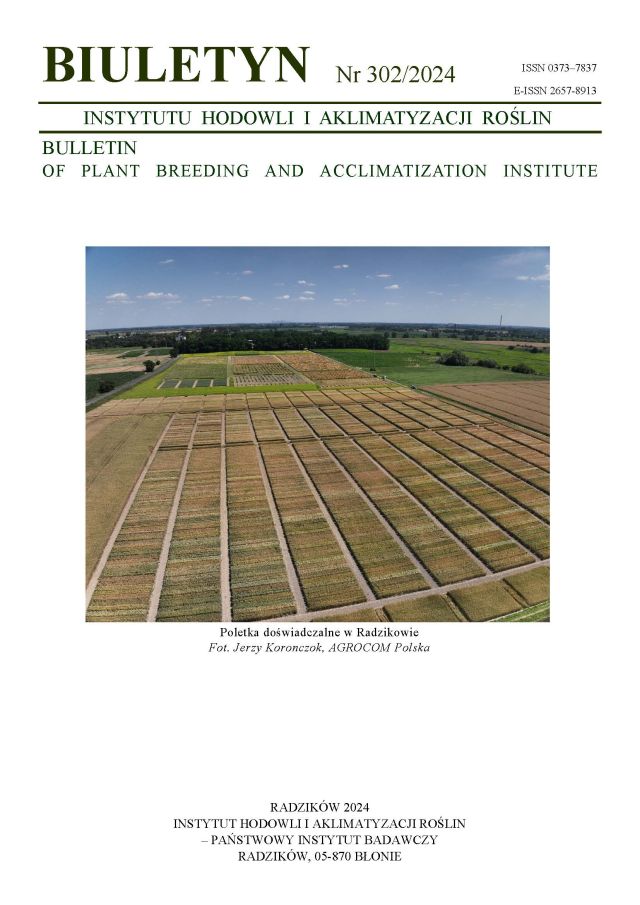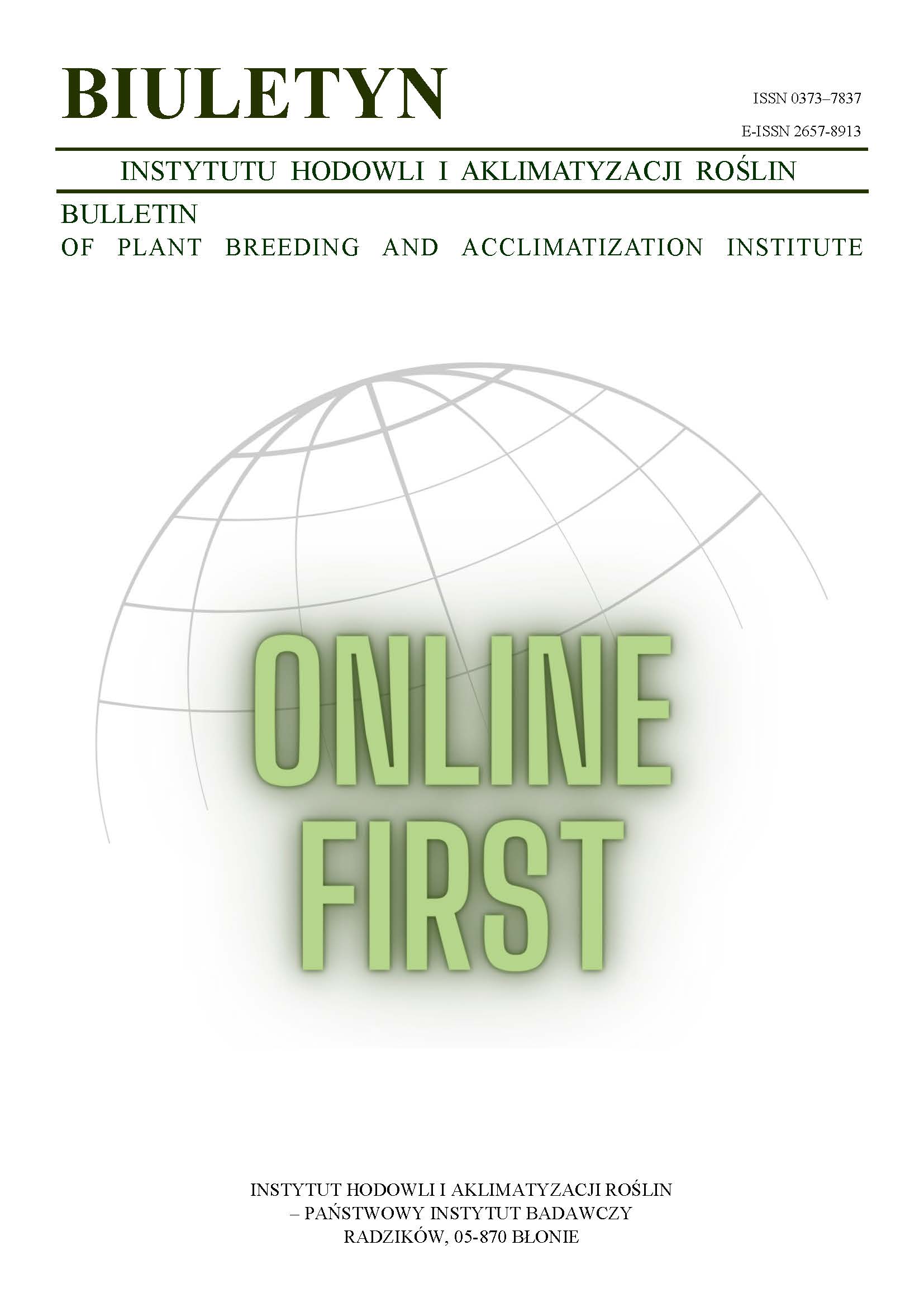Effect of sowing density and nitrogen fertilization doses on grain yield and yield components of naked short-shoot oat
Grażyna Podolska
iung@iung.pulawy.plInstytut Uprawy Nawożenia i Gleboznawstwa — Państwowy Instytut Badawczy w Puławach (Poland)
Leszek Maj
Instytut Uprawy Nawożenia i Gleboznawstwa — Państwowy Instytut Badawczy w Puławach (Poland)
Zygmunt Nita
Hodowla Roślin Strzelce Sp. z o.o. (Poland)
Abstract
The response of naked short-shoot oat STH 6503 to differentiated sowing density (3.0, 4.5, 6.0, 7.5 mln grains·ha-1) and nitrogen rates (20, 40, 60, 80 kg N·ha-1) was investigated in the field experiment carried out in the years 2003–2004. Grain yield and yield components (weight of 1000 grains, number of plants/m2, number of panicles/m2, productivity tillering, grain yield per plant, grain yield per panicle, number of grains per plant, number of grains per panicle and harvest index) were determined. The oat response to experimental factors depended on the year of study. In 2003 grain yield was highest at sowing density 7.5 mln grains/ha and 40 kg N·ha-1. In 2004 the highest grain yield was recorded at 6.0 mln grains /ha and 60 kg N·ha-1.
Keywords:
sowing density, nitrogen fertilization, naked short-shoot oat, grain yield, yield componentsReferences
Bartnikowska E., Lange E., Rakowska M. 2000. Ziarno owsa-niedocenione źródło składników odżywczych i biologicznie czynnych. Cz. I. Biul. IHAR 215: 223 — 237.
Google Scholar
Dubis B., Budzyński W., Szempliński W. 2003. Reakcja owsa nagoziarnistego na termin i gęstość siewu. Biul. IHAR 229: 139 — 146.
Google Scholar
Čermak B., Moudrý J. 1998. Comparison of grain yield and nutritive value of naked and husked oats. Acta Acad. Agricult. Tech. Olst., Agricult. 66: 89 — 98.
Google Scholar
Dzieżyc J. 1993. Czynniki plonotwórcze — plonowanie roślin. PWN Warszawa-Wrocław.
Google Scholar
Gąsiorowski H. 2000. Wartość odżywcza owsa nagiego, Wieś Jutra, 6 (23): 36 — 37.
Google Scholar
Kozłowska Ptaszyńska Z., Pawłowska J., Woch J. 2001. Wpływ terminu i gęstości siewu na plonowanie nowych odmian owsa. Biuletyn IHAR, 217: 121 — 126.
Google Scholar
Koziara W. 2004. Reakcja trzech odmian owsa na deszczowanie i nawożenie azotem. Biul. IHAR 231: 397 — 403.
Google Scholar
Kozłowska-Ptaszyńska Z., Pawłowska J., Woch J. 2000. Wpływ dawek azotu na plon i jego strukturę u nowych polskich odmian owsa. Biul. IHAR 215: 239 — 244.
Google Scholar
Nita Z. T. 1999. Stan aktualny i nowe kierunki hodowli owsa w Polsce, Żywność. Nauka. Technologa. Jakość 6 (Supl. 1): 186 — 192.
Google Scholar
Nita Z. T. 2003. Współczesne osiągnięcia i perspektywy hodowli owsa w Polsce. Biul. IHAR 229: 13 — 20.
Google Scholar
Panek K. 1989. Potrzeby wodne roślin zbożowych. Rozdział W: Potrzeby wodne roślin uprawnych. Praca zbior. J. Dzieżyc, PWN, Warszawa: 50 — 85.
Google Scholar
Peltonen-Sainio P. 1994. Yield components differences between naked and conventional oat. Agron. J. 86: 510 — 513.
DOI: https://doi.org/10.2134/agronj1994.00021962008600030010x
Google Scholar
Peltonen-Sainio P. 1997. Groat yield and plant stand structure of naked and hulled oat under different nitrogen fertilizer and seeding rates. Agron. J. 89: 140 — 147.
DOI: https://doi.org/10.2134/agronj1997.00021962008900010021x
Google Scholar
Piech M., Maciorowski R., Petkov K. 2003. Plon ziarna i składników pokarmowych owsa nieoplewionego i oplewionego uprawianego przy dwóch poziomach nawożenia azotem. Biul. IHAR 229: 103 — 113.
Google Scholar
Piech M., Nita Z., Maciorowski R. 1999. Porównanie plonowania dwóch odmian owsa nieoplewionego z oplewionym przy dwóch poziomach nawożenia azotem. Żywność. Nauka. Technologia. Jakość. (Supl. 1): 137 — 141.
Google Scholar
Rudnicki F., Wasilewski P. 1993. Wpływ doboru gatunków i ilości opadów na wydajność jarych mieszanek zbożowych. Fragm. Agron. 4 (40): 95 — 96.
Google Scholar
Wróbel E., Krajewski T., Krajewski W. 2003. Wpływ nawożenia azotem na plonowanie i strukturę plonu owsa oplewionego i nagoziarnistego. Biul. IHAR 229: 95 — 102.
Google Scholar
Walens M. 2003. Wpływ nawożenia azotowego i gęstości siewu na wysokość i jakość plonu ziarna odmian owsa oplewionego i nagoziarnistego. Biul. IHAR 229: 115 — 124.
Google Scholar
Authors
Grażyna Podolskaiung@iung.pulawy.pl
Instytut Uprawy Nawożenia i Gleboznawstwa — Państwowy Instytut Badawczy w Puławach Poland
Authors
Leszek MajInstytut Uprawy Nawożenia i Gleboznawstwa — Państwowy Instytut Badawczy w Puławach Poland
Authors
Zygmunt NitaHodowla Roślin Strzelce Sp. z o.o. Poland
Statistics
Abstract views: 33PDF downloads: 19
License
Copyright (c) 2006 Grażyna Podolska, Leszek Maj, Zygmunt Nita

This work is licensed under a Creative Commons Attribution-ShareAlike 4.0 International License.
Upon submitting the article, the Authors grant the Publisher a non-exclusive and free license to use the article for an indefinite period of time throughout the world in the following fields of use:
- Production and reproduction of copies of the article using a specific technique, including printing and digital technology.
- Placing on the market, lending or renting the original or copies of the article.
- Public performance, exhibition, display, reproduction, broadcasting and re-broadcasting, as well as making the article publicly available in such a way that everyone can access it at a place and time of their choice.
- Including the article in a collective work.
- Uploading an article in electronic form to electronic platforms or otherwise introducing an article in electronic form to the Internet or other network.
- Dissemination of the article in electronic form on the Internet or other network, in collective work as well as independently.
- Making the article available in an electronic version in such a way that everyone can access it at a place and time of their choice, in particular via the Internet.
Authors by sending a request for publication:
- They consent to the publication of the article in the journal,
- They agree to give the publication a DOI (Digital Object Identifier),
- They undertake to comply with the publishing house's code of ethics in accordance with the guidelines of the Committee on Publication Ethics (COPE), (http://ihar.edu.pl/biblioteka_i_wydawnictwa.php),
- They consent to the articles being made available in electronic form under the CC BY-SA 4.0 license, in open access,
- They agree to send article metadata to commercial and non-commercial journal indexing databases.
Most read articles by the same author(s)
- Piotr Stefański, Patrycja Siedlarz, Przemysław Matysik, Zygmunt Nita, Krystyna Rybka, The usefulness of light sources based on diodes characterized by a continuous spectrum of white light enriched with a blue band in cereal breeding , Bulletin of Plant Breeding and Acclimatization Institute: No. 284 (2018): Regular issue
- Przemysław Matysik, Zygmunt Nita, Ewelina Matysik, Effectiveness of selection criteria applied in F4 progeny of winter wheat on the basis of yield components , Bulletin of Plant Breeding and Acclimatization Institute: No. 244 (2007): Regular issue
- Patrycja Siedlarz, Piotr Stefański, Przemysław Matysik, Zygmunt Nita, Krystyna Rybka, The effect of different LED illuminators on the germination index of wheat grains obtained in the greenhouse stage of the SSD breeding process , Bulletin of Plant Breeding and Acclimatization Institute: No. 282 (2017): Regular issue
- Tadeusz Śmiałowski, Maria Bogacka, Zygmunt Nita, Edward Witkowski, The use of multifactorial analysis of variance in estimation of winter hardiness of winter wheat strains , Bulletin of Plant Breeding and Acclimatization Institute: No. 259 (2011): Regular issue
- Krystyna Rybka, Zygmunt Nita, Modern phenotypes of cereals for growing in areas endangered with drought , Bulletin of Plant Breeding and Acclimatization Institute: No. 273 (2014): Regular issue
- Grażyna Podolska, The response of winter wheat cultivars to nitrogen fertilization in plot experiments , Bulletin of Plant Breeding and Acclimatization Institute: No. 253 (2009): Regular issue
- Ryszard Weber, Grażyna Podolska, The effects of sowing term and density on size and structure of yield of winter wheat , Bulletin of Plant Breeding and Acclimatization Institute: No. 252 (2009): Regular issue
- Bogusław Łapiński, Zygmunt Nita, Aleksandra Szołkowska, Patrycja Wieczorek, A hybrid of cultivated oat with the wild species Avena macrostachya as a source of new variation for yield quality improvement in naked oats , Bulletin of Plant Breeding and Acclimatization Institute: No. 270 (2013): Regular issue
- Zygmunt Nita, Memories - Mgr Tadeusz Rydzewski (1925-2022) , Bulletin of Plant Breeding and Acclimatization Institute: No. 297/298 (2022): Regular issue
- Hanna Sulewska, Zygmunt Nita, Andrzej Kruczek, Variability of grain quality characters among spelt wheat genotypes , Bulletin of Plant Breeding and Acclimatization Institute: No. 235 (2005): Regular issue














